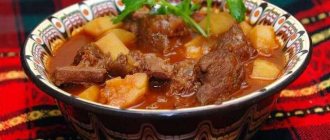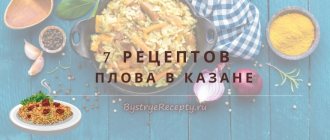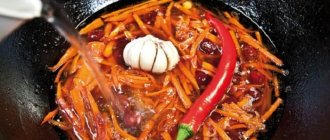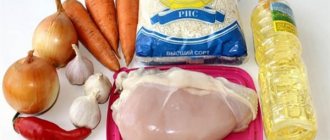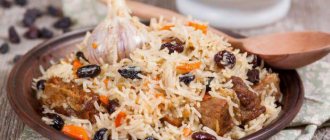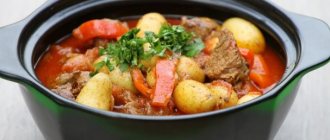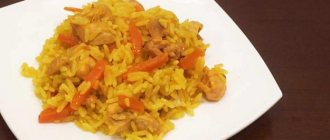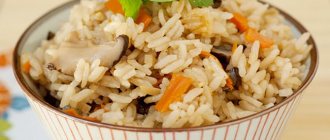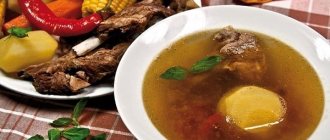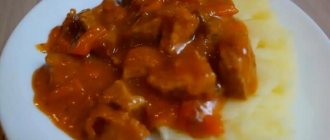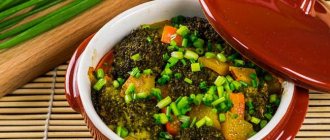Home → Recipes → Main courses ↓
Pilaf is a very ancient dish originally from the Middle East and India. Pilaf has thousands of recipes depending on the country and ingredients. But it always has two components: zirvak (or gara), which is meat (fish) with vegetables and spices, and a cereal part - rice, less often wheat, corn. We prepared our pilaf from veal and steamed rice. It turned out to be not as fatty as traditional Uzbek pilaf - you can eat it without thinking about the consequences. The dish came out very flavorful and satisfying. The specified amount of ingredients was prepared in a 4-liter cast iron cauldron.
Difficulty: high Number of servings: 8 Cooking time: 120 min
Dish rating:
1 2 3 4 5
508 people voted
Step-by-step cooking recipe
- 1.
Cut the veal into large pieces.
- 2.
Heat a cauldron over a fire, pour vegetable oil into it, place pieces of meat and fry them well on all sides, stirring.
- 3.
Cut the onion into half rings.
- 4.
Add the onion to the meat, fry for about 10 minutes until the onion becomes soft and yellowish. While the onions are frying, put the kettle on to warm up.
- 5.
Cut the carrots into strips.
- 6.
Add carrots to the meat and onions, stir, simmer for a few minutes.
- 7.
The turn of spices has come: add cumin, barberry, saffron (I have Imeretian, but let it be for color), some salt - about 1.5 teaspoons. Mix everything. On top we place whole heads of garlic, washed and plucked of excess husks.
- 8.
Pour boiling water over the meat, vegetables and spices until it covers the meat. This component of our pilaf is called zirvak in the east. Cover the cauldron with a lid, reduce the heat and cook the zirvak for about 50 minutes.
- 9.
Next we move on to the rice. We rinse it well with cold water - 5-6 times until the water becomes clear. Cover the rice with water and set aside.
- 10.
In 50 minutes our zirvak is ready. We extract the garlic from it.
- 11.
Drain the water from the rice. Place the rice on top of the meat, it is better to do this with a slotted spoon, carefully, without mixing with the meat. Scatter more salt over the surface - I put 1 teaspoon, more could be done.
- 12.
Fill 1.5-2 fingers of cold water with rice. Cover the cauldron with a lid and do not touch it until the water is almost completely absorbed into the rice.
- 13.
Next, using a large spoon, we collect the rice in a heap towards the center, drop garlic in the middle (the one that we laid out from the zirvak). Using something long (such as a skewer or the opposite side of a large spoon), make holes in a circle all the way to the bottom to allow steam to escape.
- 14.
In total, the rice in pilaf takes about half an hour to cook. The pilaf is ready when there is no liquid left in it. Next, we carefully mix our pilaf, distributing the meat and vegetables evenly.
Did you like the recipe? 108 98
Video on how to cook Uzbek beef pilaf with devzira rice
Pilaf turns out very tasty with pink devzira rice. It is, of course, not literally pink, but only has a layer of brownish-pink powder on the grain, which is washed off when the grain is washed. But the characteristic groove remains on it.
The advantage of this variety is that such grain is able to absorb all the juices and fats from the zirvak. This means it turns out not dry, but nourished, and incredibly tasty.
True, it can be difficult to buy a devzira, although if you set a goal, it is possible. I saw this variety in an expensive supermarket. And I myself order it at the market for Uzbeks who sell vegetables. They always bring the best. They understand this a lot. I couldn't even choose better than them.
The difference between this pilaf and the previous one is not only in the type of grain. if we prepared the last recipe according to the “Fergana” recipe. Then we will have this pilaf in Samarkand style.
What is the difference, see the chapter below, and all the nuances are told and shown in the video.
High resolution photos of the dish
Veal pilaf recipe. Calorie, chemical composition and nutritional value.
Nutritional value and chemical composition of “Veal pilaf”.
The table shows the nutritional content (calories, proteins, fats, carbohydrates, vitamins and minerals) per 100 grams of edible portion.
| Nutrient | Quantity | Norm** | % of the norm in 100 g | % of the norm in 100 kcal | 100% normal |
| Calorie content | 141 kcal | 1684 kcal | 8.4% | 6% | 1194 g |
| Squirrels | 6.4 g | 76 g | 8.4% | 6% | 1188 g |
| Fats | 4.8 g | 56 g | 8.6% | 6.1% | 1167 g |
| Carbohydrates | 17.8 g | 219 g | 8.1% | 5.7% | 1230 g |
| Organic acids | 0.1 g | ~ | |||
| Alimentary fiber | 1.8 g | 20 g | 9% | 6.4% | 1111 g |
| Water | 68.3 g | 2273 g | 3% | 2.1% | 3328 g |
| Ash | 0.794 g | ~ | |||
| Vitamins | |||||
| Vitamin A, RE | 432 mcg | 900 mcg | 48% | 34% | 208 g |
| beta carotene | 2.592 mg | 5 mg | 51.8% | 36.7% | 193 g |
| Vitamin B1, thiamine | 0.07 mg | 1.5 mg | 4.7% | 3.3% | 2143 g |
| Vitamin B2, riboflavin | 0.077 mg | 1.8 mg | 4.3% | 3% | 2338 g |
| Vitamin B4, choline | 41.22 mg | 500 mg | 8.2% | 5.8% | 1213 g |
| Vitamin B5, pantothenic | 0.375 mg | 5 mg | 7.5% | 5.3% | 1333 g |
| Vitamin B6, pyridoxine | 0.183 mg | 2 mg | 9.2% | 6.5% | 1093 g |
| Vitamin B9, folates | 8.853 mcg | 400 mcg | 2.2% | 1.6% | 4518 g |
| Vitamin B12, cobalamin | 0.454 mcg | 3 mcg | 15.1% | 10.7% | 661 g |
| Vitamin C, ascorbic acid | 3.3 mg | 90 mg | 3.7% | 2.6% | 2727 g |
| Vitamin E, alpha tocopherol, TE | 2.142 mg | 15 mg | 14.3% | 10.1% | 700 g |
| Vitamin H, biotin | 2.084 mcg | 50 mcg | 4.2% | 3% | 2399 g |
| Vitamin K, phylloquinone | 3.2 mcg | 120 mcg | 2.7% | 1.9% | 3750 g |
| Vitamin RR, NE | 3.1434 mg | 20 mg | 15.7% | 11.1% | 636 g |
| Niacin | 0.578 mg | ~ | |||
| Macronutrients | |||||
| Potassium, K | 176.63 mg | 2500 mg | 7.1% | 5% | 1415 g |
| Calcium, Ca | 18.33 mg | 1000 mg | 1.8% | 1.3% | 5456 g |
| Silicon, Si | 25.935 mg | 30 mg | 86.5% | 61.3% | 116 g |
| Magnesium, Mg | 26.44 mg | 400 mg | 6.6% | 4.7% | 1513 g |
| Sodium, Na | 31.27 mg | 1300 mg | 2.4% | 1.7% | 4157 g |
| Sera, S | 70.8 mg | 1000 mg | 7.1% | 5% | 1412 g |
| Phosphorus, P | 98.8 mg | 800 mg | 12.4% | 8.8% | 810 g |
| Chlorine, Cl | 39.76 mg | 2300 mg | 1.7% | 1.2% | 5785 g |
| Microelements | |||||
| Aluminium, Al | 336.4 mcg | ~ | |||
| Bor, B | 109.9 mcg | ~ | |||
| Vanadium, V | 50.57 mcg | ~ | |||
| Iron, Fe | 1.155 mg | 18 mg | 6.4% | 4.5% | 1558 g |
| Yod, I | 2.64 mcg | 150 mcg | 1.8% | 1.3% | 5682 g |
| Cobalt, Co | 2.844 mcg | 10 mcg | 28.4% | 20.1% | 352 g |
| Lithium, Li | 2.287 mcg | ~ | |||
| Manganese, Mn | 0.3486 mg | 2 mg | 17.4% | 12.3% | 574 g |
| Copper, Cu | 134.38 mcg | 1000 mcg | 13.4% | 9.5% | 744 g |
| Molybdenum, Mo | 5.318 mcg | 70 mcg | 7.6% | 5.4% | 1316 g |
| Nickel, Ni | 2.86 mcg | ~ | |||
| Rubidium, Rb | 108.9 mcg | ~ | |||
| Selenium, Se | 3.157 mcg | 55 mcg | 5.7% | 4% | 1742 g |
| Strontium, Sr | 2.37 mcg | ~ | |||
| Titanium, Ti | 3.89 mcg | ~ | |||
| Fluorine, F | 58.15 mcg | 4000 mcg | 1.5% | 1.1% | 6879 g |
| Chromium, Cr | 1.67 mcg | 50 mcg | 3.3% | 2.3% | 2994 g |
| Zinc, Zn | 1.2373 mg | 12 mg | 10.3% | 7.3% | 970 g |
| Zirconium, Zr | 1.71 mcg | ~ | |||
| Digestible carbohydrates | |||||
| Starch and dextrins | 14.404 g | ~ | |||
| Mono- and disaccharides (sugars) | 3.4 g | max 100 g | |||
| Glucose (dextrose) | 0.838 g | ~ | |||
| Maltose | 0.033 g | ~ | |||
| Sucrose | 2.236 g | ~ | |||
| Fructose | 0.489 g | ~ | |||
| Essential amino acids | 0.129 g | ~ | |||
| Arginine* | 0.143 g | ~ | |||
| Valin | 0.096 g | ~ | |||
| Histidine* | 0.039 g | ~ | |||
| Isoleucine | 0.08 g | ~ | |||
| Leucine | 0.141 g | ~ | |||
| Lysine | 0.072 g | ~ | |||
| Methionine | 0.035 g | ~ | |||
| Methionine + Cysteine | 0.067 g | ~ | |||
| Threonine | 0.062 g | ~ | |||
| Tryptophan | 0.025 g | ~ | |||
| Phenylalanine | 0.087 g | ~ | |||
| Phenylalanine+Tyrosine | 0.154 g | ~ | |||
| Nonessential amino acids | 0.272 g | ~ | |||
| Alanin | 0.099 g | ~ | |||
| Aspartic acid | 0.149 g | ~ | |||
| Glycine | 0.077 g | ~ | |||
| Glutamic acid | 0.332 g | ~ | |||
| Proline | 0.077 g | ~ | |||
| Serin | 0.077 g | ~ | |||
| Tyrosine | 0.067 g | ~ | |||
| Cysteine | 0.033 g | ~ | |||
| Sterols (sterols) | |||||
| beta sitosterol | 12.527 mg | ~ | |||
| Saturated fatty acids | |||||
| Saturated fatty acids | 0.6 g | max 18.7 g | |||
| 14:0 Miristinovaya | 0.002 g | ~ | |||
| 16:0 Palmitinaya | 0.303 g | ~ | |||
| 18:0 Stearic | 0.185 g | ~ | |||
| 20:0 Arakhinovaya | 0.013 g | ~ | |||
| 22:0 Begenovaya | 0.03 g | ~ | |||
| Monounsaturated fatty acids | 1.09 g | min 16.8 g | 6.5% | 4.6% | |
| 18:1 Oleic (omega-9) | 1.086 g | ~ | |||
| Polyunsaturated fatty acids | 2.845 g | from 11.2 to 20.6 g | 25.4% | 18% | |
| 18:2 Linolevaya | 2.62 g | ~ | |||
| Omega-6 fatty acids | 2.6 g | from 4.7 to 16.8 g | 55.3% | 39.2% |
The energy value of veal pilaf is 141 kcal.
Primary Source: Created in the application by the user. Read more.
** This table shows the average levels of vitamins and minerals for an adult. If you want to know the norms taking into account your gender, age and other factors, then use the “My Healthy Diet” application.
